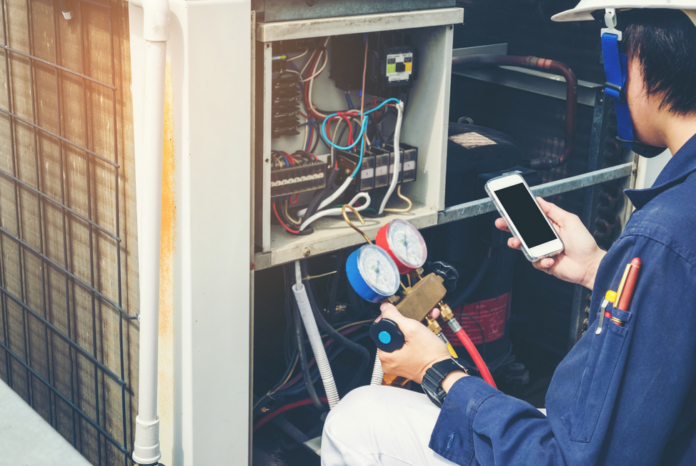If there’s one universal truth that applies to us all it’s that we cannot change or control what the weather does. But we can, however, control the internal temperature of our homes.
Whether you prefer your internal environment to be warm and balmy or a cool, steady temperature, this is where a good HVAC system comes into play.
Learn more about HVAC vs. furnace systems in this blog and if there is a difference that could benefit you.
HVAC vs. Furnace: What You Need To Know
Are these two systems different and how so? First thing’s first, an HVAC system is how most homeowners cool and warm their homes. It also plays a key role in keeping your home’s air clean and well-circulated.
There are a few different components that comprise an HVAC system:
- An air-conditioning unit
- A heat pump
- A water heater
- Thermostat
- Furnace
As you can see, a furnace is actually a key component within an HVAC system. Any HVAC technician would tell you that without it, you’d have a hard time heating up your home. Take some time to view programs on what goes into reliable HVAC technician training so you know what to look for the next time your HVAC packs up!
How Does a Furnace Work?
This is probably the largest component of an HVAC system so you’ll find most furnaces situated in either the attic or basement of a home.
In order to operate, a furnace needs a fuel source. Older furnaces tend to run on oil or gas. While more modern counterparts operate with electricity.
This fuel source heats the air that’s pulled into your home via your AC unit. A furnace has a blower motor that directs air through the ducting of your home, which then exits through supply registers.
It also sucks up cool air via return registers to repeat the process on a loop. A thermostat controls the temperature function of your furnace. For example, when your indoor temperature cools, the thermostat signals the furnace to heat up the boiler and warm your home.
How Does an AC Work?
Your air-conditioning (AC) unit is what cools down your home. It’s one of the most important components of an HVAC system, while the unit tends to sit outside the home.
The premise of how an AC works is pretty simple — it removes warm air from inside your home. Today, you have three different AC systems to choose from which include central AC, ductless, and window-mounted.
While central and ductless AC systems work in a similar way, the ductless option is far more environmentally friendly. This is because it eliminates the need for setting up ductwork throughout your home.
What most people don’t know is that a furnace and AC unit are actually connected. The blower motor services both AC and furnace function by distributing either warm or cool air.
In today’s day and age, you’ll find that many HVAC systems feature both an AC unit and a furnace.
Furnace vs. AC: Can One Work Without the Other?
Now, when it comes to the function of an HVAC system, do you need a furnace in order for the AC to work, and vice versa? The short answer is that you don’t have to choose one over the other.
A furnace and AC belong together as part of an HVAC unit. Your AC cools your home, while the furnace warms it up.
Despite the connection between your furnace and air-conditioning unit, you can have an HVAC system without either of these components.
However, it depends on your home and your local climate. Some HVAC systems might include an air-conditioner, but no furnace. If you live in a warmer climate, many HVAC systems won’t include a furnace.
In this case, you might opt for a window-mounted AC unit as it’s far more affordable and eco-friendly than central systems.
On the flip side, if you live in a region that gets very cold, HVAC installation might come standard with an in-built furnace. There is an alternative to a furnace and that’s a separate heat pump which is ideal for climates with warmer winters.
A heat pump serves the dual purpose of an AC unit and a furnace in one.
Repair and Replacement Costs To Consider
It’s a no-brainer that in order for your HVAC system to operate at its best throughout the year, you need professional installation.
It’s also important to know the signs of HVAC repair or replacement. It’s no secret that replacing an entire HVAC system is no cheap endeavor.
But the good news is that you don’t always have to replace your furnace and HVAC system at the same time. A technician can repair each component separately.
But, keep in mind that if a large part of the HVAC system needs replacing, such as the furnace, you might need to replace the entire system.
It’s difficult to tell when an HVAC system needs replacing or a simple repair. If you’re unsure, it’s best to get in touch with a contractor who can advise on the best route to take.
They’ll also be able to tell you which parts are working together at their best, and which parts drag the entire system down.
Get Your Daily Fix of General Knowledge
So, when it comes to choosing between HVAC vs. furnace you actually don’t need to fret about making this choice.
A furnace is an integral part of a functioning HVAC system, depending on your local climate and how you need to cool or warm your home. Rather, it’s about choosing an HVAC system with or without a furnace based on your needs.
Looking to broaden your general knowledge on more topics like this? Don’t miss out on the rest of this site for articles on all things tech, business, marketing, fashion, lifestyle, and more!










